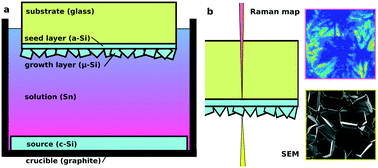Fast Raman mapping and in situ TEM observation of metal induced crystallization of amorphous silicon
Abstract
Crystalline silicon is grown onto an amorphous silicon (a-Si) seed layer from a liquid tin solution (steady state liquid phase epitaxy, SSLPE). To investigate the crystallization of embedded a-Si during our process, we adapted Raman measurements for fast mapping, with a dwell time of just one second per single measurement. A purposely developed imaging algorithm which performs point-by-point gauss fitting provides adequate visualization of the data. We produced scans of a-Si layers showing crystalline structures formed in the a-Si matrix during processing. Compared to scanning electron microscopy images which reveal merely the topography of the grown layer, new insights are gained into the role of the seed layer by Raman mapping. As part of a series of SSLPE experiments, which were interrupted at various stages of growth, we show that plate-like crystallites grow laterally over the a-Si layer while smaller, randomly orientated crystals arise from the a-Si layer. Results are confirmed by an in situ TEM experiment of the metal-induced crystallization. Contrary to presumptions, initially formed surface crystallites do not originate from the seed layer and are irrelevant to the final growth morphology, since they dissolve within minutes due to Ostwald ripening. The a-Si layer crystallizes within minutes as well, and crystallites of the final morphology originate from seeds of this layer.



 Please wait while we load your content...
Please wait while we load your content...